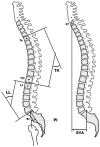Does Sagittal Spinal Alignment Predict Future Fall-Related Fractures in Community-Dwelling Women with Osteoporosis?
- PMID: 40503197
- PMCID: PMC12151287
- DOI: 10.22603/ssrr.2024-0248
Does Sagittal Spinal Alignment Predict Future Fall-Related Fractures in Community-Dwelling Women with Osteoporosis?
Abstract
Introduction: Spinal alignment in women with osteoporosis tends to deteriorate with advancing age, and this misalignment may serve as an indicator of future fall-related fractures. Vertebral fractures, which commonly occur in patients with osteoporosis, have distinct characteristics compared with other fall-related fractures and should therefore be separately evaluated. This study aimed to investigate the association between future fall-related fractures and sagittal spinal alignment, excluding vertebral fractures.
Methods: A total of 333 women with osteoporosis were recruited and followed up between November 2013 and July 2024. At baseline, information on medication status and bone mineral density in the lumbar spine and femoral neck was obtained from the patients' medical record. Furthermore, the locomotive syndrome (LOCOMO) stage was assessed via risk tests, and sagittal alignment parameters, including sagittal vertical axis (SVA), thoracic kyphosis (TK), pelvic incidence (PI), and lumbar lordosis (LL), were evaluated. In addition, Cox proportional hazards regression analysis was conducted to determine the risk of fall-related fractures based on all variables.
Results: The mean follow-up period was 5.4 years. The final sample for assessing fall-related fracture incidence consisted of 214 participants. Fall-related fractures occurred in 31 of the 333 participants (9.3%). Cox proportional hazards regression analysis, adjusted for all variables, revealed that SVA (hazard ratio [HR]=1.011, 95% confidence interval [CI] 1.003-1.02), LL (HR=1.039, 95% CI 1.007-1.072), LOCOMO stage (HR=1.801, 95% CI 1.127-2.879), and presence of parathyroid hormone (HR=0.165, 95% CI 0.031-0.891) are independent risk factors for future fall-related fractures.
Conclusions: Awareness of fall-related fracture risks can be increased by monitoring the SVA, LL, and LOCOMO stage as well as administering parathyroid hormone medications. While the deterioration of sagittal spinal alignment is a well-known factor in vertebral fractures, this study suggests that future fall-related fractures, excluding vertebral fractures, are influenced by sagittal spinal alignment.
Keywords: Locomotive syndrome; Sagittal spinal alignment; fall; fracture; osteoporosis.
Copyright © 2025 The Japanese Society for Spine Surgery and Related Research.
Conflict of interest statement
Conflicts of Interest: The authors declare that there are no relevant conflicts of interest.
Figures


Similar articles
-
Does spinal sagittal imbalance lead to future vertebral compression fractures in osteoporosis patients?Spine J. 2021 Aug;21(8):1362-1375. doi: 10.1016/j.spinee.2021.03.014. Epub 2021 Mar 22. Spine J. 2021. PMID: 33766788
-
Association with sagittal alignment and osteoporosis-related fractures in outpatient women with osteoporosis.Osteoporos Int. 2022 Jun;33(6):1275-1284. doi: 10.1007/s00198-021-06282-x. Epub 2022 Jan 29. Osteoporos Int. 2022. PMID: 35091788
-
Sagittal alignment cut-off values for predicting future fall-related fractures in community-dwelling osteoporotic women.Eur Spine J. 2023 Apr;32(4):1446-1454. doi: 10.1007/s00586-023-07599-3. Epub 2023 Feb 21. Eur Spine J. 2023. PMID: 36809343
-
Relationship between sagittal spinal alignment and the incidence of vertebral fracture in menopausal women with osteoporosis: a multicenter longitudinal follow-up study.Eur Spine J. 2015 Apr;24(4):737-43. doi: 10.1007/s00586-014-3637-8. Epub 2014 Nov 6. Eur Spine J. 2015. PMID: 25374300
-
Relationships Between Spinal Alignment and Muscle Mass in Osteoporosis Patients Over 75 Years of Age Who Were Independent and Maintained Their Activities of Daily Living.Cureus. 2021 May 19;13(5):e15130. doi: 10.7759/cureus.15130. Cureus. 2021. PMID: 34159032 Free PMC article.
References
-
- Odén A, McCloskey EV., Kanis JA, et al. Burden of high fracture probability worldwide: secular increases 2010-2040. Osteoporos Int. 2015;26(9):2243-8. - PubMed
-
- Wihlborg A, Englund M, Åkesson K, et al. Fracture predictive ability of physical performance tests and history of falls in elderly women: a 10-year prospective study. Osteoporos Int. 2015;26(8):2101-9. - PubMed
-
- Arai T, Fujita H, Maruya K, et al. The one-leg portion of the stand-up test predicts fall risk in aged individuals: a prospective cohort study. J Orthop Sci. 2020;25(4):688-92. - PubMed
-
- Asahi R, Nakamura Y, Kanai M, et al. Association with sagittal alignment and osteoporosis-related fractures in outpatient women with osteoporosis. Osteoporos Int. 2022;33(6):1275-84. - PubMed
LinkOut - more resources
Full Text Sources
Research Materials
Miscellaneous
